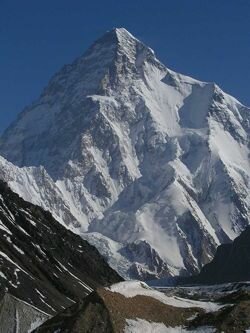Principles of Peak Classification
It is natural to want to classify peaks into tables. A table needs to be based on a method of classifying peaks by geographic location and size. It also needs to provide information that is clear and useful to the user. But what makes a good classification?

K2
Photographer: Bartek Szumski,
reproduced under the terms of the GNU
Free Documentation License, Version 1.2
Is the second highest mountain in the world K2 or Everest�s South Summit? There is no doubt that the highest summit in the world is Everest at a height of 8848 metres. The South Summit of Everest is 8749 metres and higher than K2 at 8611 m, yet nobody would seriously suggest that the South Summit is the �second highest mountain� in the world.
Why is this? Well, the South Summit is a mere bump on Everest�s summit ridge standing out by a mere 10 metres (a P10 summit!). In contrast, K2 has a prominence of 4017 metres and is therefore an outstanding and important summit (a P2000). The whole point is that summit height alone does not define the significance of a peak. The whole context, that is whether a summit is indeed a mere bump or the dominant peak of an area, is hugely important. This means that a combination of prominence and height is a key criterion for classifying peaks.
Absolute height and prominence alone is not sufficient to describe the context. Clearly the scale of a range of mountains or hills needs to play a role. In the European Alps, a height requirement of say 500 metres is not appropriate; the Bavarian plateau is already at that level or higher. On the other hand, for the Bavarian Alps a prominence requirement of 500 m and a minimum height criterion of say 1000 m or more would result in a reasonable peak list. However, this would not be a sufficiently stringent criterion for a compact list of Alpine summits. There a height criterion of at least 2000 m and prominence criterion of 500 m or even 1000 m would make more sense.
For the Himalayas, a height criterion of 2000 metres would be quite insufficient. A height criterion of at least 5000 m and prominence of 1000 m (or even 2000 m) would produce a coherent list.
Clearly there is a need to match height and prominence criteria to the scale of a range. For height it is necessary to choose criteria that reflect nearby plateau areas and typical elevations.
The UK and Ireland are a family of islands, so the issue of plateau areas does not arise. The authors have concluded that good criteria for the UK are a minimum height of 500 metres and prominence of 100 metres. This is the basis for the UK Prominent Peaks database.
It is possible to apply the same thinking to peak classification by prominence, regardless of whether you are focussed on the Himalaya or the English Cotswolds. Summits may be classified into geometrically growing groups. Having groups with sensible prominence thresholds can be achieved by the 1-2-5 principle.
To apply these principles to creating lists of peaks, accurate data relating to height of peaks and their key cols (and other cols so that the key col can be confirmed) is needed. Geographic boundaries for a list also need to be determined. It is necessary to decide on how many levels of prominence categories will be included and the type of height qualification. This determines how long the list will be. Is it to be a database of information or a more compact listing of important peaks? Both approaches have merit and may indeed be complementary.